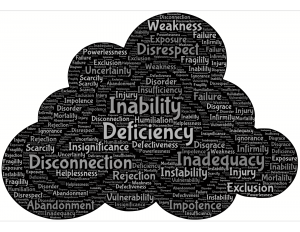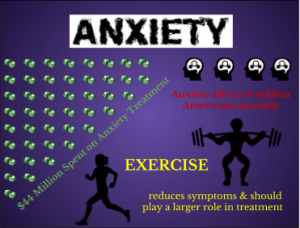By: Karli Willson, Cara Daniels, Caitlin Pellegrino, Chandler Rhodes, Malorie Kalens, Lillian Sherrill
Keywords: Anxiety, worry, exercise, improvements, activity
Anxiety-What is it Really?
Anxiety is an emotion that can be characterized by psychological stress and worry. Anxiety activates the sympathetic nervous system, also known as the fight-or-flight response, and floods the blood with the hormone, adrenaline. Adrenaline causes the symptoms associated with anxiety such as panic attacks, increased heart rate, sweating, and insomnia. It is a normal reaction to stress and can be beneficial. When anxiety starts to interfere with everyday life, it might be an anxiety disorder. Anxiety disorders are different from just normal feelings of nervousness and involve constant and excessive worrying. According to the American Psychiatric  Association, anxiety disorders are the most common mental disorders and affect more than 25 million Americans (2017).
Association, anxiety disorders are the most common mental disorders and affect more than 25 million Americans (2017).
The good news is anxiety disorders are treatable!
Feel The Difference
Exercise has been shown to improve anxiety symptoms and is even comparable to other anxiety treatments. Some changes that occur include better concentration and quality of life as well as decreased worrying and fatigue. Many of these changes occur because of better self-esteem, exposure to exercise, and an expectation of improvement. You can see changes in your anxiety symptoms with even just a little exercise, but significant changes come from 150 minutes of exercise a week. These effects have also been shown to be long-term. Many people that have participated in an exercise program for only eight weeks at the recommended amount of 150 minutes or more have experienced decreases in anxiety symptoms even after one year (Herring, Lindheimer, & O’Connor, 2014).
to be long-term. Many people that have participated in an exercise program for only eight weeks at the recommended amount of 150 minutes or more have experienced decreases in anxiety symptoms even after one year (Herring, Lindheimer, & O’Connor, 2014).
What Now?
So, what kind of activities can be done to help with anxiety? Research shows that both aerobic exercises, such as walking or jogging, and resistance training can help decrease symptoms of anxiety. Here is a list of different exercises or you can choose another form that you enjoy:
❖ Walk, run, or jog
❖ Swimming
❖ Tennis
❖ Soccer
❖ Playing Catch
❖ Rock Climbing
❖ Weight Lifting
❖ Skiing
❖ Skating
❖ Boxing
❖ Dancing
❖ Gardening
To feel the difference, all you need to do is get your heart pumping for 150 minutes a week. You can also hit two birds with one stone because the American College of Sports Medicine (ACSM), recommends the same amount of exercise for health benefits (2013). All you need to do now is explore your options and find something you enjoy! Just get up and play for 30 minutes a day.
References
American College of Sports Medicine (2013). ACSM’s guidelines for exercise testing and prescription (9th ed.). Philadelphia, PA: Lippincott Williams &Wilkins.
American Psychiatric Association. (2017). What Are Anxiety Disorders? Retrieved from American Psychiatric Association:
https://www.psychiatry.org/patients-families/anxiety-disorders/what-are-anxiety-disordes Herring, M., Lindheimer, J., & O’Connor, P. (2014). The effects of exercise training on anxiety. American Journal of Lifestyle Medicine, 8(6), 388-403.